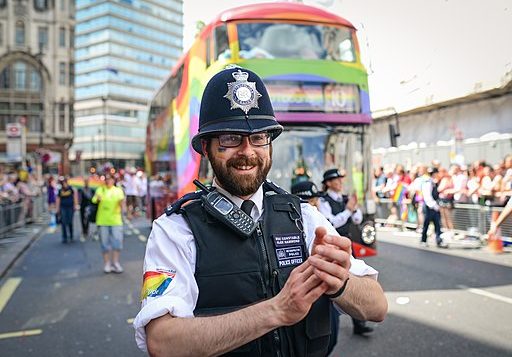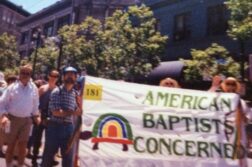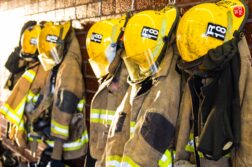
On July 1st 1972, the first Gay Pride March took place in central London. Fifty years on, during the troubled summer of 2022 the occasion was marked in numerous ways, from news articles and dusted off television archives to parties, while others, who had seen it all before, half-raised an eyebrow, kept calm, and carried on. Had I not been doing some online research for the book I’m writing on my thirty year career as a British police officer, I too may have missed the significant milestone, but that research took me to the US -based G&LR and then I remembered, ‘hey, I was there’! But what of the here and now and the years in between? How has the past connected with the present?
Those years in between saw my two police forces (the Metropolitan Police and the Hampshire Constabulary) organisations not noted for their speed of changing step, gradually modified their approach to ‘policing’ homosexuality from one of pure enforcement to one of liaison, discussion and empathy, and although agreement was not always reached, the dialogue remained and blossomed. The bulk of my service was in the 3,500 strong Hampshire force and among the changes I saw the appointment of lesbian and gay liaison officers and latterly, as a senior officer, I myself became a point of contact for a Portsmouth-based gay mens health concern. Are you now wondering if I’m a heterosexual? Does it matter?
So what of 2022? Having been in touch with a former colleague with fingers much closer to the pulse than mine, I am concerned about what he describes as the increasing ‘clash that is occurring between some trans rights and womens rights’. A headline in ‘The Times’ (U.K.) said, “Feminist society ‘purged’ by trans rights activists at Swansea University”. He went on; ‘This intolerant anti-women activity is going on in Universities across the U.K. and is both disturbing and outrageous’. Even as I type this, he has messaged me with an article on ‘Vice.com’ with the headline, “Trans Activists Left Over 60 Bottles of Piss Outside the EHRC” (Equalities and Human Rights Commission). Really?
I hope that fanatics and those with extreme and entrenched views who appear to have taken over large parts of the LGBTQ++ movement (including Stonewall, media and police LGBT liaison channels) don’t start another war and put us back in the dark days before that first Gay Pride march. Debates that are stifled, an increase in incidents of violence particularly against lesbians as well as absolutism and dogma replacing calm and reasoned debate, does not auger well and creates an atmosphere of danger and deep suspicion – and where have we seen that before?
That Gay Pride day on July 1st 1972 was filled with hope and determination and much has been achieved since. I do not like the huge cracks appearing in those first laid foundations. Below is my story from that sunny day in London, in the Summer of ‘72.
The first “Gay Pride” march in the UK was scheduled for 1st July, 1972. Me and several coach-loads of my mates were going to join them. Well we were going to be policing the march, which wasn’t quite the same thing. Prior to this day, my only contact with gay men, as far as I knew, was my pal Malcolm (landlord of the pub opposite my single men’s quarters in Victoria) and his small entourage of companions. I felt this gave me, if not full empathy with their secret lives, at least an appreciation for them, and given the right circumstances – we could have a meaningful exchange and maybe a laugh. I was not to be disappointed. The briefing in one of the lecture theatres at Scotland Yard was an upbeat affair, with the emphasis from the event commander being on good humor and plenty of communication with the marchers. There were a few jovial comments and innuendos that Kenneth Williams and Hugh Paddick of ‘Julian and Sandy’ fame would’ve been proud of, though I doubt the marchers would have been impressed (See BBC’s ‘Round the Horne’) but, overall, we were in good spirits. Most of us had experienced far less pleasant public order duties even though we were young service members. And policing in central London meant our learning curve was steep and our progress up it, too fast. That day’s march was looking to be a walk in the park – Piccadilly Circus, Regent Street, Oxford Street and Hyde Park, to be more precise.
The atmosphere was as upbeat as it could have been under the circumstances. By that I mean it was the first of its kind. In hindsight it was a bit over-policed, but in fairness the Met had little past experience to draw on other than enforcement of a law since repealed, plus the Gay Liberation Front (GLF) were fairly new kids on the block in the UK. Two years earlier in ’69, there was a big riot at The Stonewall Inn gay bar in New York City. The previous year, in September ‘71 an organization called the ‘Festival of Light’ with the decency campaigners Mary Whitehouse and Lord Longford, held a meeting at London’s Central Hall which was disrupted by GLF gatecrashers, some in drag, so you can surely forgive the Met for expecting trouble but hoping for a peaceful outcome, After al,l we were also there to facilitate the demonstration and protect the protestors. As it was, there were plenty of my colleagues who did not like the marchers one little bit and despite the briefing calling for impartiality, there were disparaging remarks been passed between some police officers and the marchers.
From my static position on the march, near the Wimpy Bar at the Marble Arch end of Oxford Street, I thought it was almost the perfect demonstration; loud, proud, a bit outrageous in places but its point was being well made. I was highly amused when one group started chanting “two four six eight; is that copper really straight?,” although it wasn’t clear who that was directed at, but whoever it was it was bloody funny. I said it was ‘almost’ the perfect demonstration, because there was a bit of a scuffle as the demonstrators approached my position. Two members of staff from the Wimpy had come out to watch the spectacle and I’d spoken briefly to them a few minutes before. I think they were Mexican but whatever their nationality English certainly wasn’t their first language. They suddenly spotted a couple of ‘nuns’ in the march and as they got closer stared in disbelief, for the ‘nuns’ were also wearing full beards and moustaches. Not being religious, this did not bother me, but I did empathize with those of the Roman Catholic Church, who had every reason to be outraged. The two Wimpy staff started shouting in Spanish as they rushed at these two guys. They ended up rolling about in the middle of Oxford Street but two policemen from the outside of the march dived in, dragged the two waiters off and marched them to the side of the road. The two “nuns” were none the worse for their ungodly experience and disappeared as the march moved on. I don’t believe any arrests were made and although it met the criteria for an arrest for ‘threatening behavior’, it was probably written off as ‘advice given’, discretion being the order of the day. The march ended in a loud gathering in Trafalgar Square.
For my part, on looking back over the last fifty years, I always smile when I think I was part of that first ‘Gay Pride’ event. Over the years police liaison has improved massively and, from my own personal involvement with local representatives, I can say it was a good way to address problems. Personally, I disapprove of police cars painted in rainbow colors, of officers wearing rainbow ties and badges and having rainbow ‘warpaint’ on their faces whilst on duty and if I was still serving, and had the authority, I would not allow it. Policing is supposed to be non-political and impartial. If they want to take part then that’s fine by me, but it should be in their own time and their own clothes. At that first march, we were briefed to be communicative, understanding, fair and reasonable. I firmly believe that was the right approach then and that it should prevail today. I find this trend of police ‘virtue signaling’ to be as condescending as it is excruciating and it fools no one. I’d much rather the police continued to improve the quality and empathy of how they support LGBT+ people and deal robustly with their failings in reported cases of homophobic crime when it is flagged up. Ideally, a zero police presence at UK Pride marches would be wonderful, but whilst there remains the threat of extremist opponents attacking the marchers, then there will be a police presence, duty bound to preserve The Queen’s Peace (no pun, it’s what it’s called in Britain!).
 Geoff Cadman describes himself not as a ‘retired police officer’ but as a guy who was ‘once a police officer’ – a big difference! Serving 32 years in the Metropolitan Police (London) and the Hampshire Constabulary, after retirement at the rank of Chief Inspector he worked for ‘Victim Support’ and then as head of the National Firearms Centre at the Royal Armouries. He is a lifelong motorcyclist and lives with his wife, Ali, in Suffolk.
Geoff Cadman describes himself not as a ‘retired police officer’ but as a guy who was ‘once a police officer’ – a big difference! Serving 32 years in the Metropolitan Police (London) and the Hampshire Constabulary, after retirement at the rank of Chief Inspector he worked for ‘Victim Support’ and then as head of the National Firearms Centre at the Royal Armouries. He is a lifelong motorcyclist and lives with his wife, Ali, in Suffolk.




